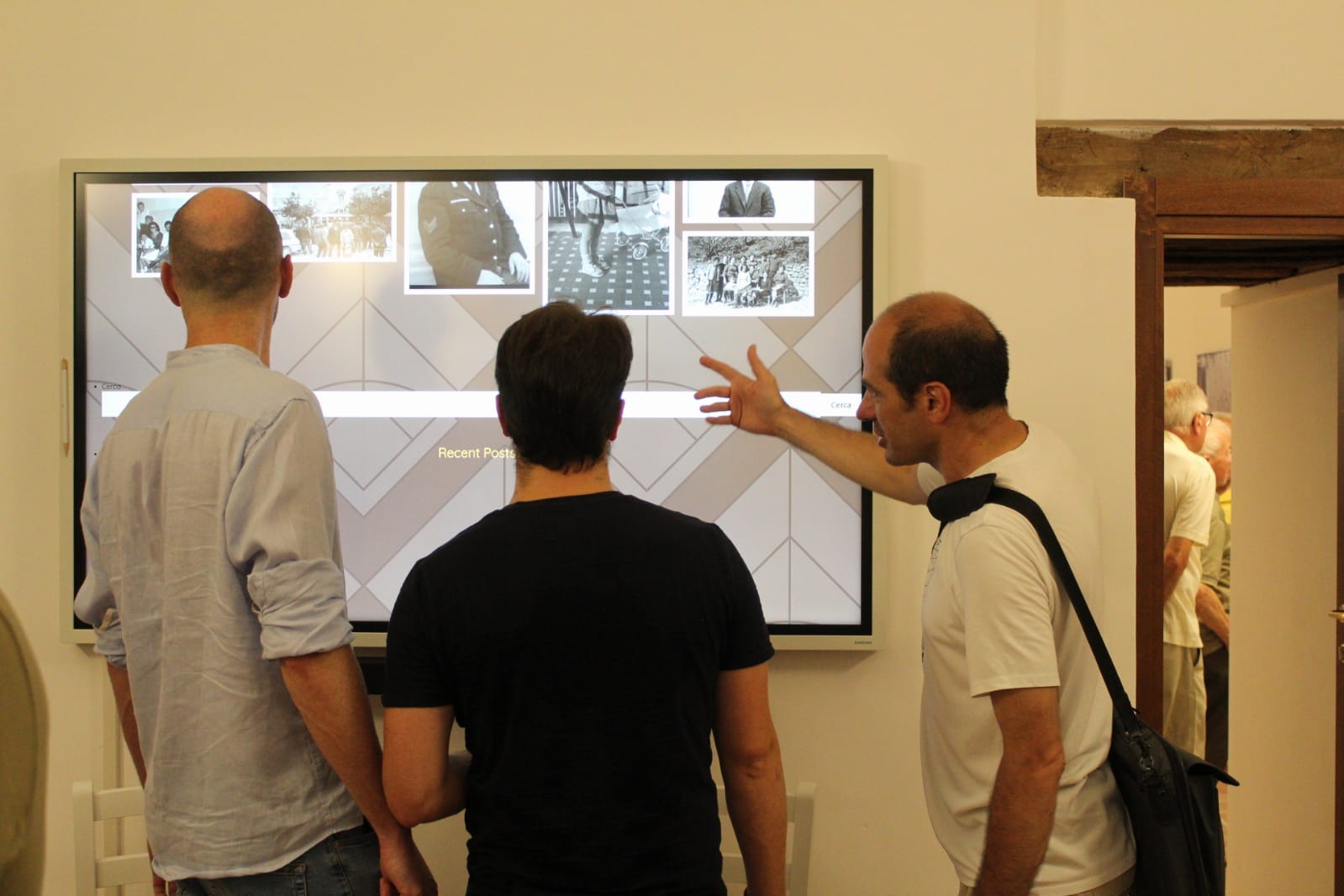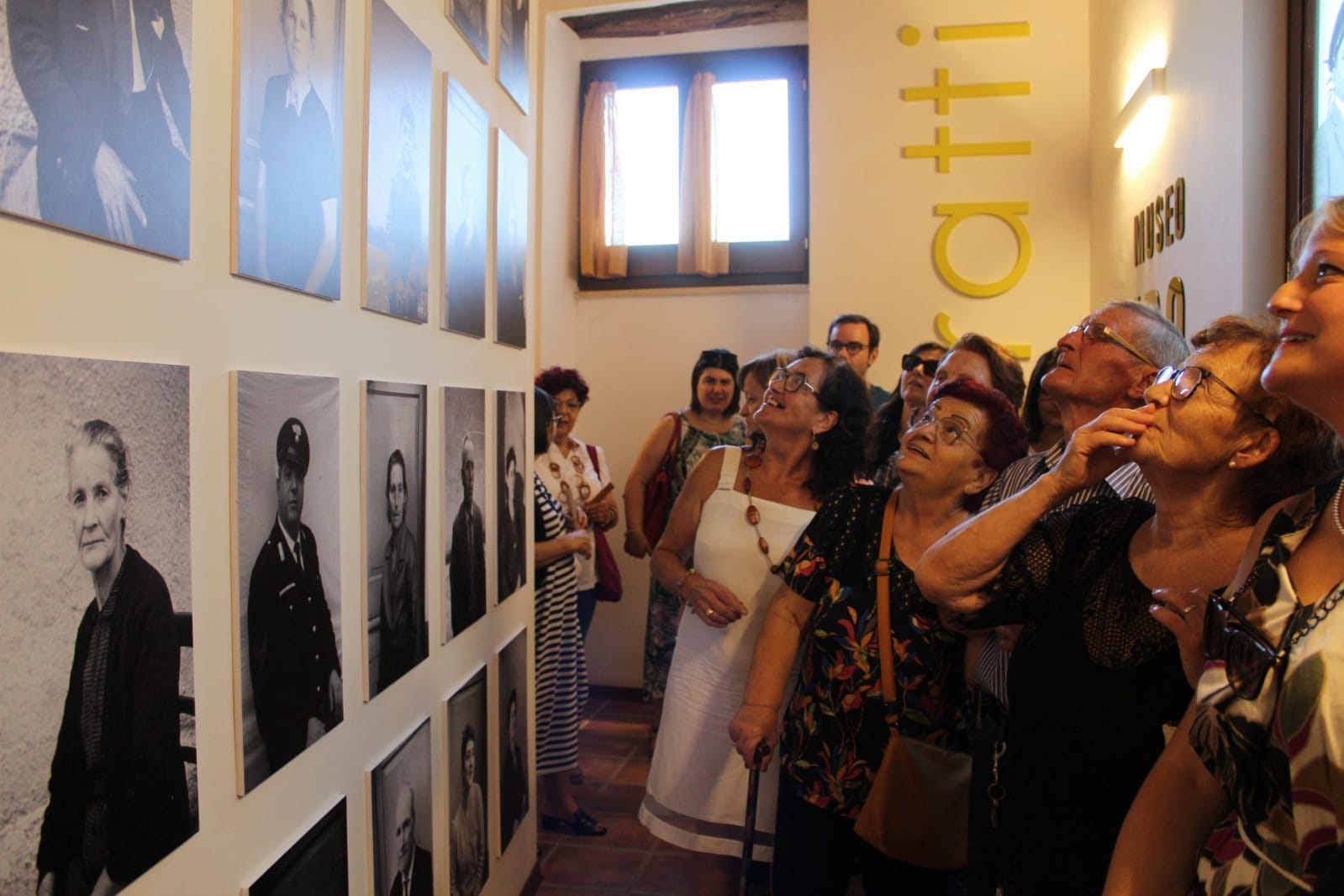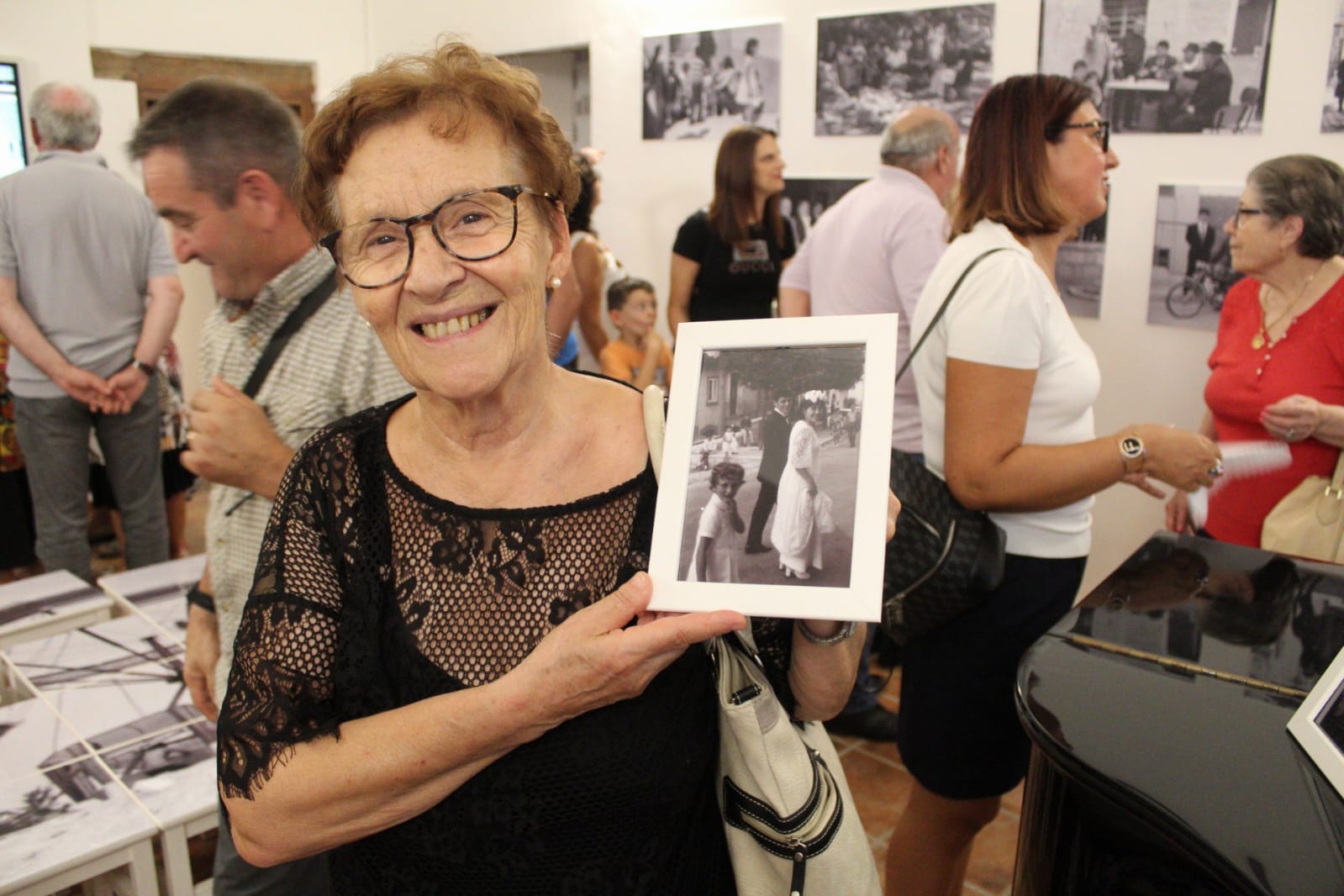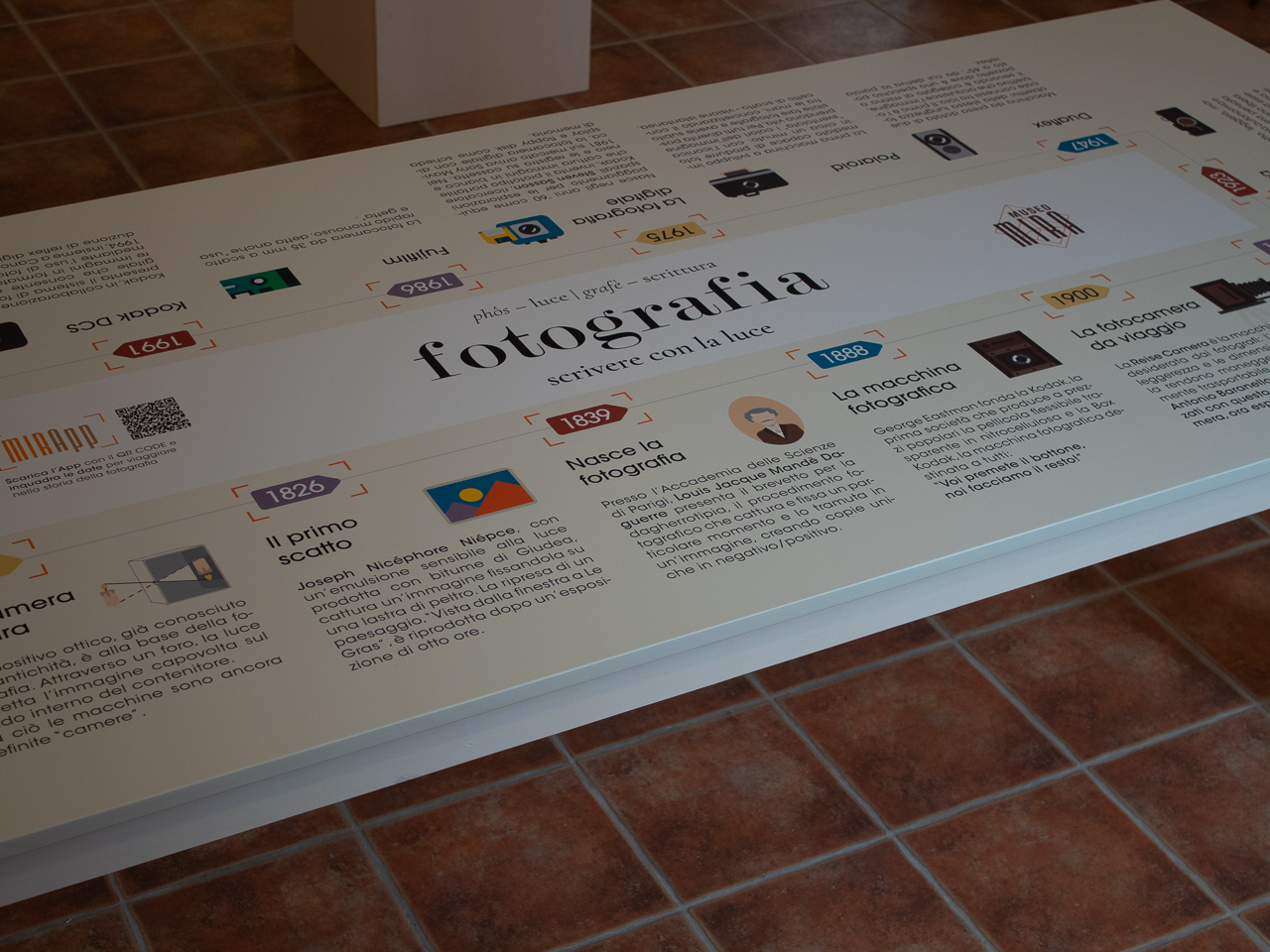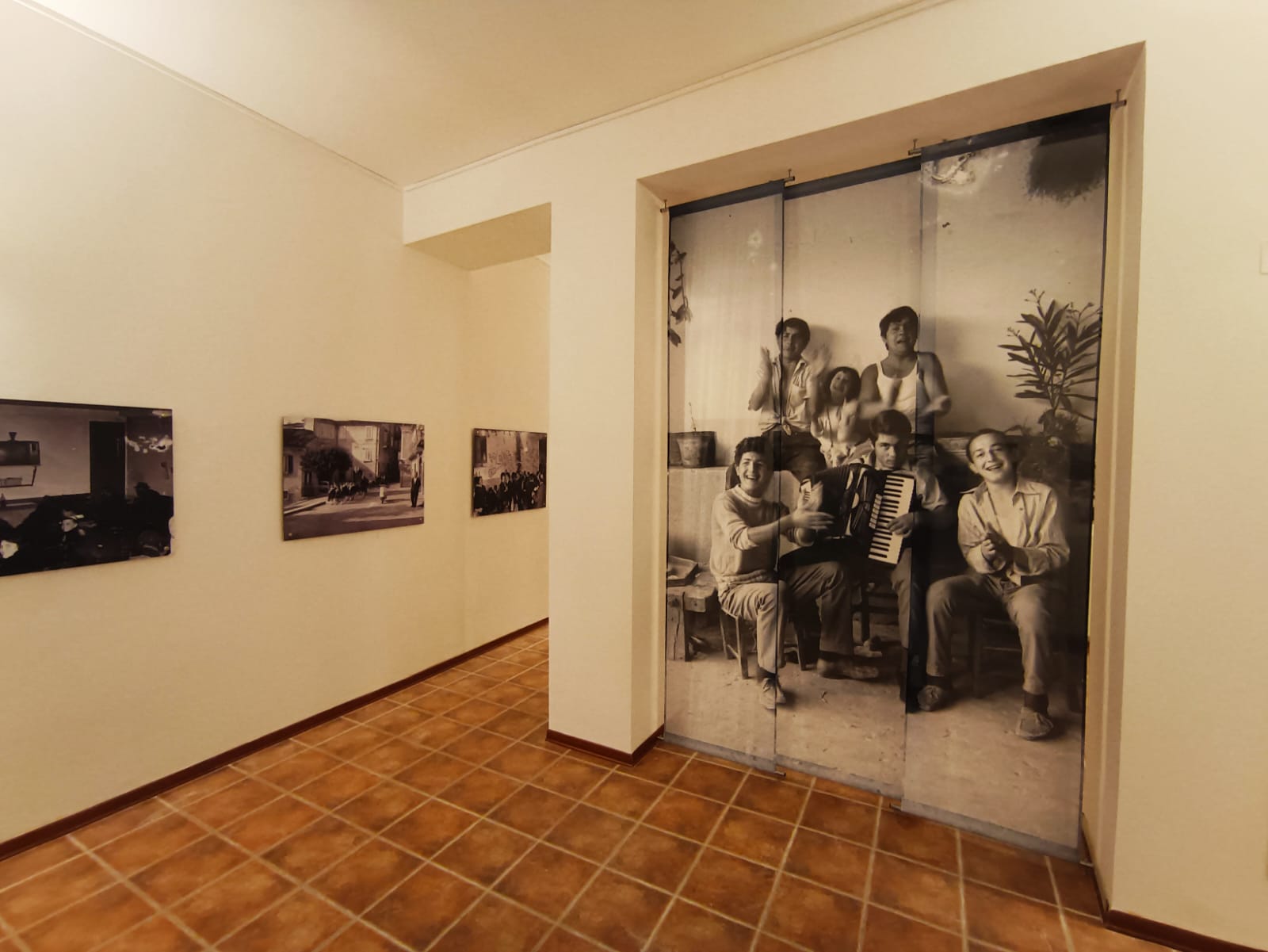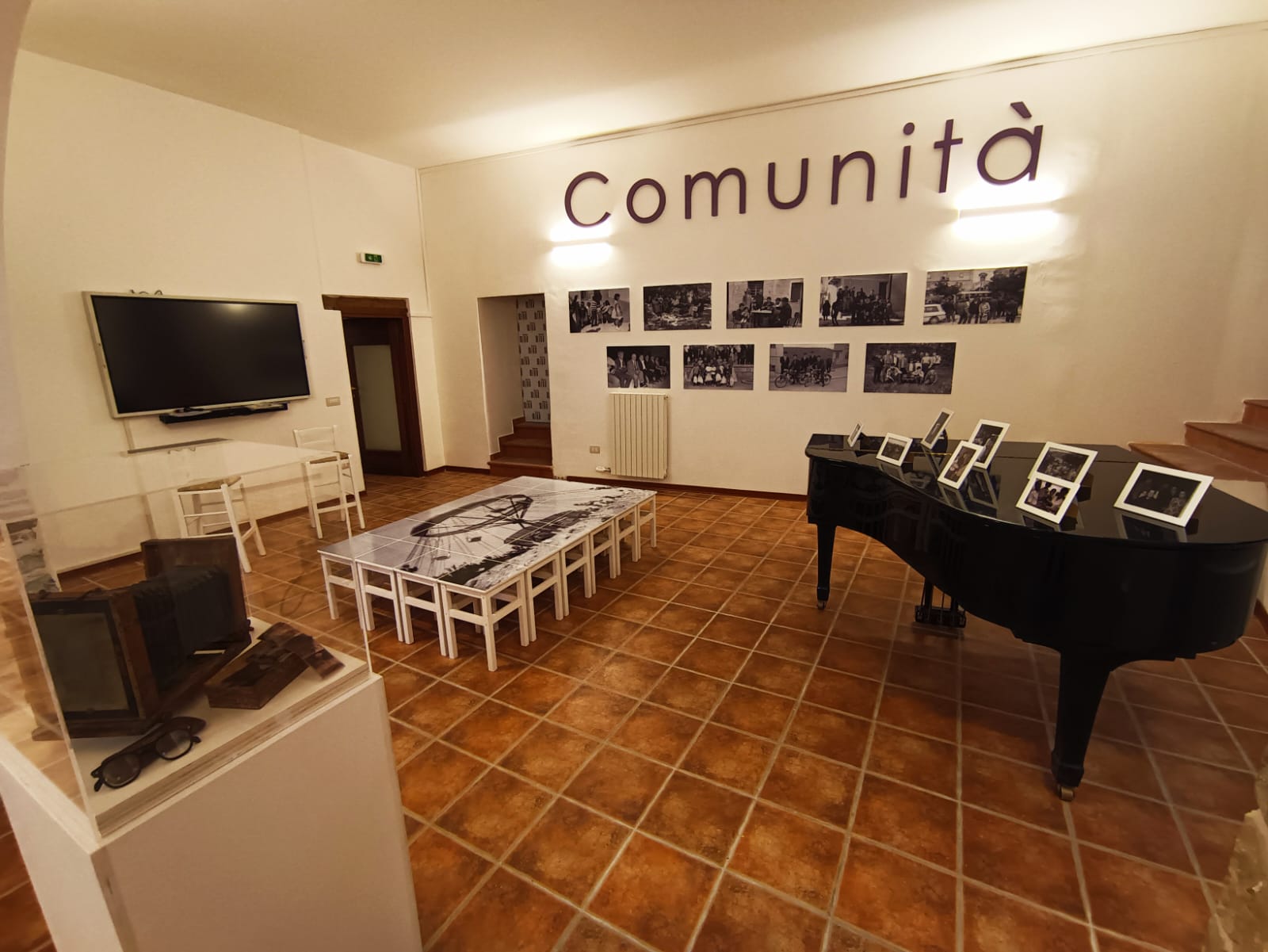Regaining a sense of belonging
Museo MIRA
Museo MIRA – Mirabello Immagini e Racconti
The project focused on enhancing the tangible and intangible heritage of the municipality of Mirabello Sannitico, with the aim of promoting the cultural legacy handed down by past generations. A museum exhibition was created featuring photographs by local photographer Antonio Baranello, which represent moments from the community's past, and a participatory archive was established to facilitate the recovery of local and individual memories of which the community is the guardian.
Italy
Local
Mirabello Sannitico
Mainly rural
It refers to other types of transformations (soft investment)
Yes
2023-07-25
No
No
Yes
Yes
Yes
As a representative of an organisation
The MIRA Museum - Mirabello Immagini e Racconti was established with the aim of enhancing the photographic and cultural heritage of Mirabello Sannitico.
Thanks to the strong participation of residents with a focus on new generations, the elderly and people at risk of social marginalization, the museum has stimulated a dialogue between past and present. The digitization of about 550 photographs from a collection of 5,500 negatives belonging to Mirabello photographer Antonio Baranello has made it possible to return to the community images that tell stories of daily life, events, traditions and transformations of the territory during the twentieth century.
The initiative had a significant impact on the enhancement of the old town through the recovery of the spaces of Palazzo Spicciati, where the museum came to life. From this iconographic group were extrapolated the 4 thematic sections of the museum: Portraits, Feasts, Community, Land. Among the various photos it is also possible to admire the photographer's “working tools” thanks to a special display case. The construction of the participatory archive, which can be consulted through a touchscreen in the conference room, has fostered the recovery of local and individual memoirs of which the community is the custodian, thanks to the activation of tags and keywords each person can associate with the photographs in the archive useful information for the construction of the public history of Mirabello.
The use of digital technologies for heritage preservation has reduced the risk of deterioration of images, ensuring their long-term enjoyment. Participatory archiving has made the process accessible to everyone, giving them the opportunity to contribute information and memories, strengthening the sense of community. The detailed aesthetics of the museum layout transformed the visual narrative into an immersive experience, able to excite and engage every visitor.
Thanks to the strong participation of residents with a focus on new generations, the elderly and people at risk of social marginalization, the museum has stimulated a dialogue between past and present. The digitization of about 550 photographs from a collection of 5,500 negatives belonging to Mirabello photographer Antonio Baranello has made it possible to return to the community images that tell stories of daily life, events, traditions and transformations of the territory during the twentieth century.
The initiative had a significant impact on the enhancement of the old town through the recovery of the spaces of Palazzo Spicciati, where the museum came to life. From this iconographic group were extrapolated the 4 thematic sections of the museum: Portraits, Feasts, Community, Land. Among the various photos it is also possible to admire the photographer's “working tools” thanks to a special display case. The construction of the participatory archive, which can be consulted through a touchscreen in the conference room, has fostered the recovery of local and individual memoirs of which the community is the custodian, thanks to the activation of tags and keywords each person can associate with the photographs in the archive useful information for the construction of the public history of Mirabello.
The use of digital technologies for heritage preservation has reduced the risk of deterioration of images, ensuring their long-term enjoyment. Participatory archiving has made the process accessible to everyone, giving them the opportunity to contribute information and memories, strengthening the sense of community. The detailed aesthetics of the museum layout transformed the visual narrative into an immersive experience, able to excite and engage every visitor.
Community engagement
Participatory archive
Museum itinerary
Community stories
Photographic collection
The MIRA project ensures its sustainability through active community involvement in collecting, interpreting, and disseminating collective memories. This approach strengthens the sense of belonging and responsibility in protecting local history, transforming the museum into a dynamic space.
The participatory archive is a key element of this sustainability: every citizen can contribute by identifying faces, places, and moments captured in the photographs, enriching the museum's visual and narrative heritage. This collaborative process ensures that historical memory doesn't remain static but is reinterpreted and updated over time.
Community stories are at the heart of the MIRA project, not just as a legacy of the past, but as a common good that lives through collective participation.
Through sharing and dialogue, the museum becomes an open, inclusive, and accessible space, where cultural heritage is a tool for connection between generations, between those who live in Mirabello and those who are far away.
Antonio Baranello's photographic collection represents the material foundation of the project, and its sustainability depends on making it accessible to the community. The digitization of images, creation of an online archive, and educational activities ensure the preservation and enhancement of this heritage. The technologies used and innovative practices ensure its transmission over time.
The museum itinerary itself has been designed with sustainability in mind, enhancing local heritage through a dynamic and participatory exhibition. The use of existing spaces, low-impact materials, and digital solutions reduces waste, while active community involvement allows the museum to evolve over time. In this way, MIRA not only protects the past but builds a future of participation and cultural awareness.
The participatory archive is a key element of this sustainability: every citizen can contribute by identifying faces, places, and moments captured in the photographs, enriching the museum's visual and narrative heritage. This collaborative process ensures that historical memory doesn't remain static but is reinterpreted and updated over time.
Community stories are at the heart of the MIRA project, not just as a legacy of the past, but as a common good that lives through collective participation.
Through sharing and dialogue, the museum becomes an open, inclusive, and accessible space, where cultural heritage is a tool for connection between generations, between those who live in Mirabello and those who are far away.
Antonio Baranello's photographic collection represents the material foundation of the project, and its sustainability depends on making it accessible to the community. The digitization of images, creation of an online archive, and educational activities ensure the preservation and enhancement of this heritage. The technologies used and innovative practices ensure its transmission over time.
The museum itinerary itself has been designed with sustainability in mind, enhancing local heritage through a dynamic and participatory exhibition. The use of existing spaces, low-impact materials, and digital solutions reduces waste, while active community involvement allows the museum to evolve over time. In this way, MIRA not only protects the past but builds a future of participation and cultural awareness.
The MIRA Museum offers an immersive and engaging experience, where aesthetics and design merge to enhance collective memory.
The community engagement translates into a living museum in constant transformation, where the public is not just a spectator but an active part in constructing the visual narrative.
The participatory archive is designed with an accessible and intuitive aesthetic: the digital design of the platform allows exploration of images through keywords and tags, transforming consultation into a visual and emotional journey. The interactive system enables visitors to actively contribute, making each experience unique and personal. This approach not only makes the photographic heritage accessible to all but invites the public to feel part of its evolution.
The community stories are narrated through an exhibition path that creates a multisensory experience immersing visitors in Mirabello's past life. The main themes of the exhibition path include rural life, popular festivals, family relationships, traditional crafts, and emigration, offering an authentic look at local history.
The museum experience unfolds in environments designed to stimulate curiosity and interaction. The exhibition setup respects the history of Palazzo Spicciati, integrating modern elements and innovative display solutions that ensure a balance between tradition and contemporaneity. The fluid arrangement of spaces invites discovery, while the use of sustainable materials and welcoming lighting solutions makes the visit a pleasant experience accessible to all.
Antonio Baranello's photographic collection is presented with aesthetic care that enhances its artistic and documentary value. The MIRA museum thus presents itself as an exemplary model of cultural heritage enhancement, demonstrating how design can amplify the public's experience and make memory a shared asset.
The community engagement translates into a living museum in constant transformation, where the public is not just a spectator but an active part in constructing the visual narrative.
The participatory archive is designed with an accessible and intuitive aesthetic: the digital design of the platform allows exploration of images through keywords and tags, transforming consultation into a visual and emotional journey. The interactive system enables visitors to actively contribute, making each experience unique and personal. This approach not only makes the photographic heritage accessible to all but invites the public to feel part of its evolution.
The community stories are narrated through an exhibition path that creates a multisensory experience immersing visitors in Mirabello's past life. The main themes of the exhibition path include rural life, popular festivals, family relationships, traditional crafts, and emigration, offering an authentic look at local history.
The museum experience unfolds in environments designed to stimulate curiosity and interaction. The exhibition setup respects the history of Palazzo Spicciati, integrating modern elements and innovative display solutions that ensure a balance between tradition and contemporaneity. The fluid arrangement of spaces invites discovery, while the use of sustainable materials and welcoming lighting solutions makes the visit a pleasant experience accessible to all.
Antonio Baranello's photographic collection is presented with aesthetic care that enhances its artistic and documentary value. The MIRA museum thus presents itself as an exemplary model of cultural heritage enhancement, demonstrating how design can amplify the public's experience and make memory a shared asset.
The MIRA Museum is a concrete example of inclusion, accessibility and active community participation.
Through community engagement, the museum acts as a place for intergenerational dialogue where every citizen can contribute to the collective narrative.
The participatory archive is a digital and cultural inclusion tool that allows the community to actively interact with the photographic heritage. The intuitive and accessible interface guarantees the possibility of contributing to the historical narrative, even from a distance, encouraging the involvement of people with reduced mobility or fellow emigrants who used to live in Mirabello. This democratization of access to collective memory creates a new model of society in which culture is constructed by everyone.
Community stories are presented through an itinerary that enhances often forgotten voices, such as those of women, workers, the elderly, and young people. Collective storytelling restores an authentic and inclusive image of local society.
The museum itinerary is designed to be accessible to all, with barrier-free spaces and multimedia content that expands the possibilities of enjoyment. Free or affordable admission ensures that cultural heritage is a shared asset and not a luxury for the few, making the museum a model of cultural equity and inclusion.
Antonio Baranello's photographic collection becomes a means of narrating a society in transformation, highlighting the links between past and present. Its digitization and online accessibility allow everyone to rediscover their roots, strengthening a sense of belonging and promoting a model of participatory cultural governance. In this way, the MIRA Museum establishes itself as an innovative example of inclusion, demonstrating that collective memory can be the engine for a more equitable, aware and connected society.
Through community engagement, the museum acts as a place for intergenerational dialogue where every citizen can contribute to the collective narrative.
The participatory archive is a digital and cultural inclusion tool that allows the community to actively interact with the photographic heritage. The intuitive and accessible interface guarantees the possibility of contributing to the historical narrative, even from a distance, encouraging the involvement of people with reduced mobility or fellow emigrants who used to live in Mirabello. This democratization of access to collective memory creates a new model of society in which culture is constructed by everyone.
Community stories are presented through an itinerary that enhances often forgotten voices, such as those of women, workers, the elderly, and young people. Collective storytelling restores an authentic and inclusive image of local society.
The museum itinerary is designed to be accessible to all, with barrier-free spaces and multimedia content that expands the possibilities of enjoyment. Free or affordable admission ensures that cultural heritage is a shared asset and not a luxury for the few, making the museum a model of cultural equity and inclusion.
Antonio Baranello's photographic collection becomes a means of narrating a society in transformation, highlighting the links between past and present. Its digitization and online accessibility allow everyone to rediscover their roots, strengthening a sense of belonging and promoting a model of participatory cultural governance. In this way, the MIRA Museum establishes itself as an innovative example of inclusion, demonstrating that collective memory can be the engine for a more equitable, aware and connected society.
The MIRA Museum has generated a strong impact on the community of Mirabello Sannitico, offering citizens new opportunities for participation, learning, and rediscovery of their collective identity. The project has stimulated a sense of belonging, actively involving residents of all ages in the collection, interpretation, and dissemination of local memories. For many, contact with the photographs from the Baranello collection has represented an emotional journey into the past, allowing them to recognize familiar faces and places transformed by time.
Thanks to the participatory archive, citizens have not been mere spectators but true protagonists in the museum's construction, enriching the collection with stories, testimonies, and previously unpublished details. This process has strengthened the bond between generations, creating a space for dialogue between elderly and young people, between those who lived through the past and those who can now reinterpret it. The digital interface has also made it possible to extend involvement to emigrants from Mirabello, offering them a virtual bridge to their homeland and creating a shared experience beyond geographical distances.
The museum has become a reference point for the community, a place to come together, reflect, and celebrate their cultural heritage.
The project's impact has also extended to economic and tourism aspects: the enhancement of heritage has attracted visitors and scholars, increasing interest in the territory and creating opportunities for small local businesses. The community has rediscovered the value of its history not only as a memory to preserve but as a living resource for building the future. In this way, the MIRA Museum has established itself as a model of cultural engagement, capable of generating social well-being and new perspectives for the territory.
Thanks to the participatory archive, citizens have not been mere spectators but true protagonists in the museum's construction, enriching the collection with stories, testimonies, and previously unpublished details. This process has strengthened the bond between generations, creating a space for dialogue between elderly and young people, between those who lived through the past and those who can now reinterpret it. The digital interface has also made it possible to extend involvement to emigrants from Mirabello, offering them a virtual bridge to their homeland and creating a shared experience beyond geographical distances.
The museum has become a reference point for the community, a place to come together, reflect, and celebrate their cultural heritage.
The project's impact has also extended to economic and tourism aspects: the enhancement of heritage has attracted visitors and scholars, increasing interest in the territory and creating opportunities for small local businesses. The community has rediscovered the value of its history not only as a memory to preserve but as a living resource for building the future. In this way, the MIRA Museum has established itself as a model of cultural engagement, capable of generating social well-being and new perspectives for the territory.
The MIRA Museum was created through the collaboration of various stakeholders who contributed to the project's realization and sustainability, each bringing fundamental added value. The Municipality of Mirabello Sannitico, the initiative's promoter, played a key role in coordinating and providing exhibition spaces, ensuring that the project met the local community's needs.
The Municipality of Vinchiaturo, a project partner, encouraged the involvement of a broader territorial area, strengthening the cultural network between neighboring communities and promoting the joint enhancement of the area's rural and historical heritage.
The local farms represented an additional element connecting historical heritage and rural landscape, contributing to the narrative of the relationship between memory, territory, and productive traditions. Their involvement allowed the integration of elements of material culture and the region's agri-food identity into the museum experience, offering visitors a more immersive and authentic experience.
The creation of the MIRA Museum was entrusted to the Campobasso cultural cooperative justMO', which oversaw the conception and setup of the museum exhibition with an innovative and participatory approach. Thanks to their experience in managing cultural projects, the museum was conceived as a dynamic, accessible, and inclusive space, capable of combining tradition and innovation through multimedia and interactive solutions.
The added value of this stakeholder network lies in its ability to unite institutional, cultural, and economic expertise to create a project that not only preserves historical memory but makes it alive and accessible for future generations. The collaboration between public and private sectors has enabled the development of a sustainable cultural model capable of generating lasting benefits for the territory and its community.
The Municipality of Vinchiaturo, a project partner, encouraged the involvement of a broader territorial area, strengthening the cultural network between neighboring communities and promoting the joint enhancement of the area's rural and historical heritage.
The local farms represented an additional element connecting historical heritage and rural landscape, contributing to the narrative of the relationship between memory, territory, and productive traditions. Their involvement allowed the integration of elements of material culture and the region's agri-food identity into the museum experience, offering visitors a more immersive and authentic experience.
The creation of the MIRA Museum was entrusted to the Campobasso cultural cooperative justMO', which oversaw the conception and setup of the museum exhibition with an innovative and participatory approach. Thanks to their experience in managing cultural projects, the museum was conceived as a dynamic, accessible, and inclusive space, capable of combining tradition and innovation through multimedia and interactive solutions.
The added value of this stakeholder network lies in its ability to unite institutional, cultural, and economic expertise to create a project that not only preserves historical memory but makes it alive and accessible for future generations. The collaboration between public and private sectors has enabled the development of a sustainable cultural model capable of generating lasting benefits for the territory and its community.
The project involved multiple disciplines and sector-specific knowledge, integrating innovative methodologies for enhancing cultural heritage and its inclusive fruition. History and archival research were fundamental to the project, with the analysis and digitization of Antonio Baranello's photographic collection. The historical approach enabled the reconstruction of Mirabello's twentieth-century visual memory, valorizing the images as testimony of local identity. The research methodology included photograph analysis, comparison with oral and written sources, and direct citizen involvement in reconstructing the stories behind the photographs.
Museum design and exhibition setup played a key role in creating an accessible and engaging experience. Through the use of interactive and multimedia solutions, the museum went beyond a simple display of images to create an immersive and multisensory experience. The conservation and digitization of photographic materials required expertise in both archival and technological fields. High-resolution scanning and cataloging work ensured the long-term preservation of the images, making them accessible online as well. The digital archive was designed to be expandable over time, offering citizens the opportunity to actively contribute with information and new images.
Finally, community involvement was made possible through participatory methodologies inspired by community engagement. The interaction between these disciplines has made the MIRA Museum an innovative model of cultural enhancement, where the past intertwines with the present through modern tools, offering an experience that goes beyond simple exhibition to become a process of continuous rediscovery and participation.
Museum design and exhibition setup played a key role in creating an accessible and engaging experience. Through the use of interactive and multimedia solutions, the museum went beyond a simple display of images to create an immersive and multisensory experience. The conservation and digitization of photographic materials required expertise in both archival and technological fields. High-resolution scanning and cataloging work ensured the long-term preservation of the images, making them accessible online as well. The digital archive was designed to be expandable over time, offering citizens the opportunity to actively contribute with information and new images.
Finally, community involvement was made possible through participatory methodologies inspired by community engagement. The interaction between these disciplines has made the MIRA Museum an innovative model of cultural enhancement, where the past intertwines with the present through modern tools, offering an experience that goes beyond simple exhibition to become a process of continuous rediscovery and participation.
The MIRA Museum represents an innovative project in the landscape of cultural and museum enhancement, thanks to the integration of participatory methodologies, advanced digital tools, and a dynamic approach to preserving collective memory. Unlike traditional museums, which often limit themselves to displaying heritage without active public involvement, MIRA has developed an interactive and accessible model, transforming the museum into a living space for exchange and participation.
One of the most innovative elements has been the co-creation process with the community, which has made citizens protagonists in building cultural heritage. The community engagement has allowed for the collection and interpretation of local stories in a shared way, moving beyond the static concept of an archive and transforming it into an evolving resource. The participatory archive, also available online, allows users to actively contribute with information, identifications, and stories related to historical photographs, ensuring constant growth of the museum's heritage.
The use of digitization and interactive technologies is another innovative aspect. Through the creation of a digital archive accessible both on-site and remotely, the museum has broken down physical barriers, allowing access even to Mirabello emigrants abroad. The museum is not just a display of images but a dynamic environment where visitors are encouraged to interact, recognize themselves in the exhibited stories, and actively contribute to their enrichment.
Finally, the MIRA Museum stands out for its approach to cultural and social sustainability. The project has gone beyond creating an exhibition space to activate a long-term enhancement system based on active participation and intergenerational knowledge transmission.
One of the most innovative elements has been the co-creation process with the community, which has made citizens protagonists in building cultural heritage. The community engagement has allowed for the collection and interpretation of local stories in a shared way, moving beyond the static concept of an archive and transforming it into an evolving resource. The participatory archive, also available online, allows users to actively contribute with information, identifications, and stories related to historical photographs, ensuring constant growth of the museum's heritage.
The use of digitization and interactive technologies is another innovative aspect. Through the creation of a digital archive accessible both on-site and remotely, the museum has broken down physical barriers, allowing access even to Mirabello emigrants abroad. The museum is not just a display of images but a dynamic environment where visitors are encouraged to interact, recognize themselves in the exhibited stories, and actively contribute to their enrichment.
Finally, the MIRA Museum stands out for its approach to cultural and social sustainability. The project has gone beyond creating an exhibition space to activate a long-term enhancement system based on active participation and intergenerational knowledge transmission.
The project has developed through a methodological approach based on active community participation, the integration of new technologies, and the enhancement of local heritage in an inclusive and sustainable way. The adopted methodology followed an interdisciplinary model, combining tools of historical research, innovative archival practices, exhibition design, and social engagement strategies. The discovery of the important photographic collection occurred by chance in 2004 by architect Vincenzo Miniello, who recovered a substantial quantity of films and negatives stored in shopping bags in the home of his uncle, Marshal Nicola Baranello, the photographer's son. Having immediately understood the historical and cultural value of the salvaged material, a decision was made to digitize the black and white images to prevent further loss of the recovered visual sources. The collected material was produced by Antonio Baranello over 40 years of activity and primarily concerns stories of the Mirabello community. This patient and meticulous work resulted in the recovery of over 5,500 negatives. The first phase therefore involved the recovery, digitization, and cataloging of the photographic collection. This operation was not limited to mere documentary preservation but activated a process of participatory archiving, inviting citizens to contribute with stories and information, thus transforming the photographic heritage into a continuously evolving corpus. Alongside, work was done on the design of the museum itinerary, developed with an inclusive and interactive design. A key element of the project was the participatory approach and community engagement, which saw the direct involvement of the population in constructing the museum's narrative.
The MIRA Museum project represents a replicable model in various contexts thanks to the combination of digital technologies, participatory methodologies, and cultural heritage enhancement strategies. Its replicability is based on a scalable approach that can be adapted to different territorial realities while ensuring sustainability and community involvement.
From a technological perspective, the digitization process of the photographic collection and the creation of an online archive accessible through a web interface constitute an example of best practices applicable to other documentary heritage. The digital platform, in addition to preserving and making images accessible, allows interaction with the public through the addition of tags, comments, and testimonials. This model can be replicated for the enhancement of other historical archives, both photographic and documentary, ensuring democratic and inclusive access.
The participatory methodologies adopted in the project, such as the participatory archive and community engagement, offer a cultural management model based on collaboration between institutions, citizens, and local stakeholders. This strategy can be applied to other contexts to stimulate active participation of communities in protecting their heritage, strengthening the sense of belonging and shared responsibility.
The project's management processes also offer replicable insights. The involvement of public entities, local businesses, and cultural cooperatives has demonstrated the effectiveness of shared governance models that can be adopted in other contexts.
Finally, the MIRA model can be applied in other communities that wish to recover and enhance their historical memory, demonstrating how the synergy between technological innovation, social participation, and cultural enhancement can generate a lasting and sustainable impact.
From a technological perspective, the digitization process of the photographic collection and the creation of an online archive accessible through a web interface constitute an example of best practices applicable to other documentary heritage. The digital platform, in addition to preserving and making images accessible, allows interaction with the public through the addition of tags, comments, and testimonials. This model can be replicated for the enhancement of other historical archives, both photographic and documentary, ensuring democratic and inclusive access.
The participatory methodologies adopted in the project, such as the participatory archive and community engagement, offer a cultural management model based on collaboration between institutions, citizens, and local stakeholders. This strategy can be applied to other contexts to stimulate active participation of communities in protecting their heritage, strengthening the sense of belonging and shared responsibility.
The project's management processes also offer replicable insights. The involvement of public entities, local businesses, and cultural cooperatives has demonstrated the effectiveness of shared governance models that can be adopted in other contexts.
Finally, the MIRA model can be applied in other communities that wish to recover and enhance their historical memory, demonstrating how the synergy between technological innovation, social participation, and cultural enhancement can generate a lasting and sustainable impact.
The project addresses several major global challenges through solutions rooted in the local context, demonstrating how cultural heritage can become a driver of sustainable development, social cohesion, and innovation.
One of the most urgent global issues is the loss of collective memory and cultural identity, often threatened by globalization, depopulation of small centers, and community dispersion. MIRA responds to this challenge through the digitization and sharing of Antonio Baranello's photographic collection, creating a participatory archive that preserves local history and makes it globally accessible.
Another global challenge is that of social inclusion and democratic participation in culture. Often, access to cultural assets is limited by economic, physical, or digital barriers. The MIRA Museum has developed an inclusive museum itinerary that, through community engagement, invites citizens of all ages and social conditions to actively contribute to the construction of collective narrative. This approach promotes social cohesion, creating a space where elderly people, youth, residents, and emigrated Mirabello natives can reconnect with their history.
In terms of environmental sustainability, the project demonstrates how it's possible to combine heritage conservation with technological innovation. The digitization of images prevents physical degradation of original materials and reduces the environmental impact of temporary exhibitions and events. Furthermore, the restoration of Palazzo Spicciati as the museum headquarters represents a concrete example of regenerating existing spaces without consuming new land.
Finally, the MIRA Museum responds to the global need for new forms of cultural and creative economy. The synergy between public entities, local agricultural businesses, and cultural cooperatives demonstrates how heritage can generate new opportunities for sustainable development.
One of the most urgent global issues is the loss of collective memory and cultural identity, often threatened by globalization, depopulation of small centers, and community dispersion. MIRA responds to this challenge through the digitization and sharing of Antonio Baranello's photographic collection, creating a participatory archive that preserves local history and makes it globally accessible.
Another global challenge is that of social inclusion and democratic participation in culture. Often, access to cultural assets is limited by economic, physical, or digital barriers. The MIRA Museum has developed an inclusive museum itinerary that, through community engagement, invites citizens of all ages and social conditions to actively contribute to the construction of collective narrative. This approach promotes social cohesion, creating a space where elderly people, youth, residents, and emigrated Mirabello natives can reconnect with their history.
In terms of environmental sustainability, the project demonstrates how it's possible to combine heritage conservation with technological innovation. The digitization of images prevents physical degradation of original materials and reduces the environmental impact of temporary exhibitions and events. Furthermore, the restoration of Palazzo Spicciati as the museum headquarters represents a concrete example of regenerating existing spaces without consuming new land.
Finally, the MIRA Museum responds to the global need for new forms of cultural and creative economy. The synergy between public entities, local agricultural businesses, and cultural cooperatives demonstrates how heritage can generate new opportunities for sustainable development.
The MIRA Museum project has generated significant impact on the local community and involved stakeholders, with direct and indirect effects ranging from cultural heritage enhancement to the creation of new opportunities for territorial participation and development.
From a quantitative perspective, results were measured through active participation in workshops and business visits, with a substantial number of members exceeding initial expectations. The museum experience has recorded a steady flow of visitors, with structured data by origin and age groups that has allowed identification of both a local audience and growing interest from external visitors. Analysis of online trends has shown an increase in access to the museum's digital platform and social media pages, indicating active engagement even beyond the physical dimension of the exhibition space.
Qualitative analysis has highlighted a strong sense of belonging and active community involvement. Through mapping participants' interests and concerns, it was possible to better understand citizens' expectations and the perceived value of the project. Audio/video recordings and photographic documentation have captured moments of intergenerational interaction and exchange.
The direct impact of the project is reflected in the creation of an ever-expanding participatory archive, which has allowed citizens to actively contribute to the collective narrative. The indirect effects of the project include increased tourist and cultural attractiveness of the territory, with a positive impact on local economies, particularly on the involved agricultural businesses.
Finally, the project's potential user base demonstrates MIRA's ability to extend beyond the boundaries of the Municipality of Mirabello Sannitico, also involving Vinchiaturo and the urban area of Campobasso.
From a quantitative perspective, results were measured through active participation in workshops and business visits, with a substantial number of members exceeding initial expectations. The museum experience has recorded a steady flow of visitors, with structured data by origin and age groups that has allowed identification of both a local audience and growing interest from external visitors. Analysis of online trends has shown an increase in access to the museum's digital platform and social media pages, indicating active engagement even beyond the physical dimension of the exhibition space.
Qualitative analysis has highlighted a strong sense of belonging and active community involvement. Through mapping participants' interests and concerns, it was possible to better understand citizens' expectations and the perceived value of the project. Audio/video recordings and photographic documentation have captured moments of intergenerational interaction and exchange.
The direct impact of the project is reflected in the creation of an ever-expanding participatory archive, which has allowed citizens to actively contribute to the collective narrative. The indirect effects of the project include increased tourist and cultural attractiveness of the territory, with a positive impact on local economies, particularly on the involved agricultural businesses.
Finally, the project's potential user base demonstrates MIRA's ability to extend beyond the boundaries of the Municipality of Mirabello Sannitico, also involving Vinchiaturo and the urban area of Campobasso.

